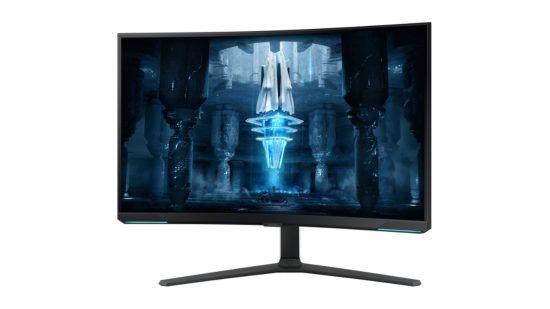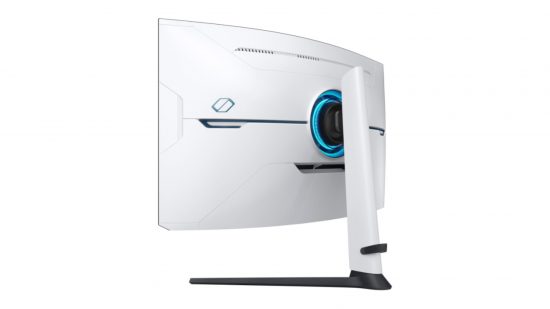Our Verdict
90%Incredible technology supplies a near-unmatched 4K experience, despite some design niggles.
The Samsung Odyssey Neo G8 is the first gaming monitor to combine a curve with a 4K resolution and a 240Hz refresh rate, and the impressive specifications don’t stop there – the G8 also uses a 10-bit VA panel with advanced backlighting. The 4K resolution keeps the image crisp, the 1000R curve is immersive and the 240Hz refresh rate is plenty for most people’s needs, plus this monitor will adaptively sync with both AMD and Nvidia GPUs to stop image tearing and stutter.
The 1,196 Samsung Quantum Mini LEDs that make up the backlight alter their brightness levels independently to deliver stunning contrast that’s ideal for HDR.
It’s not cheap at $1,400, but the Samsung is still more affordable than the Asus ROG Swift PG32UQX, which costs $3,200 and includes 1,152 backlighting zones across its 32in IPS screen, alongside a weaker 144Hz refresh rate.
On the outside, the G8 has glossy white plastic and good movement options. Around the rear, the G8 deploys two HDMI 2.1 ports, a DisplayPort 1.4 socket and two USB 3.2 Gen 1 ports, but no USB Type-C connection. The G8 also has front and rear-mounted RGB LEDs that aren’t bright or versatile enough to be useful. An absence of tool-free building disappoints as well, and the shallow, unresponsive D-pad undermines the slick on-screen display.
Those physical issues occasionally irritate, but the G8 fully redeems itself in benchmarks. Out of the box, the G8 supplied a sensational contrast ratio of 9,600:1 thanks to a 0.02-nit black point – this panel delivers more depth and vibrancy than any conventional IPS or VA screen. Not surprisingly, the G8 also performed well in HDR tests, with a peak brightness of 1,411 nits, creating a revised contrast ratio of 70,550:1. The Asus is great here too, but the Samsung is even better, and it makes games look fantastic.
The Samsung’s delta E of 2.17 and colour temperature of 6,065K are middling but accurate enough for gaming, although the Asus is marginally better here. The G8 also rendered 99.5 per cent of the sRGB gamut with 129.8 per cent volume and 91.2 per cent of the DCI-P3 space at 92 per cent volume, so it produces a broad, vibrant range of colours in both gamuts without looking oversaturated.
Meanwhile, the G8’s 240Hz performance is crisp and smooth, with only modest ghosting visible in dark areas. Without overdrive, the G8’s average initial response time of 7.58ms is quite high, and limits this panels appeal for the most demanding esports uses. However, with adaptive sync deactivated and the Standard overdrive setting applied the response time improved to 3.47ms, which is excellent. In the Faster and Extreme overdrive modes, the response times improved further to 2.7ms and 2.38ms, but colour overshoot increased dramatically resulting in poor image quality. If you want extra speed while games remain visually impressive, we’d stick with the Standard option.
Samsung Odyssey Neo G8 pros and cons
Pros
- Sensational contrast
- Fantastic backlight
- Good colours
- Excellent core specification
Cons
- Needs a mighty GPU
- Some exterior design issues
- Not the best for serious esports
Samsung Odyssey Neo G8 specs
The Samsung Odyssey Neo G8 specs list is:
| Screen size | 32in |
| Resolution | 3,840 x 2,160 |
| Panel technology | VA |
| Maximum refresh rate | 240Hz |
| Stated response time | 1ms |
| Max brightness | 400cd/m² SDR, 2000cd/m² HDR |
| Backlight zones | 1 |
| Stated contrast ratio | 1,000,000:1 |
| Adaptive sync | AMD FreeSync Premium Pro, Nvidia G-Sync compatible |
| Display inputs | 1 x DisplayPort 1.2a, 2 x HDMI 2 |
| Audio | N/A |
| Stand adjustment | Height, tilt, swivel |
| Extras | 100 x 100mm VESA mount, 2 x USB-C 3.2 Gen 1 |
Samsung Odyssey Neo G8 price
The Samsung Odyssey Neo G9 price is $1,400, making it a very expensive gaming monitor, but then it does have a 32-inch screen size, 4K resolution, and 240Hz refresh rate.
Price: Expect to pay $1,400 USD (£1,299)
Samsung Odyssey Neo G8 review conclusion
The G8’s VA panel might not quite have the responsiveness required for top-tier esports, but it has the speed for any other gaming scenario, alongside good colour reproduction, incredible contrast and a rock-solid core spec. While you’ll need to spend a lot of money on this monitor, and a GPU that can output to 4K at high frame rates, there’s no denying that the G8 delivers the best all-round 16:9 gaming experience around today, earning it a place on out best gaming monitor list.

